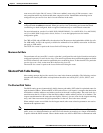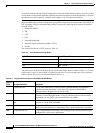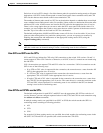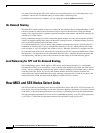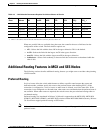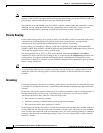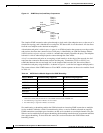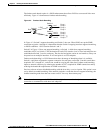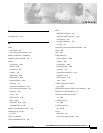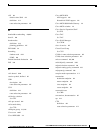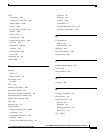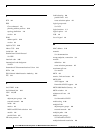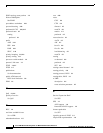
4-11
Cisco PNNI Network Planning Guide for MGX and SES Products, Release 5
Part Number OL-3847-01 Rev. D0, April, 2004
Chapter 4 Planning Intermediate Route Selection
Additional Routing Features in MGX and SES Nodes
The farthest-node branch option is a PNNI enhancement that allows PNNI to use network links more
efficiently. Figure 4-2 demonstrates farthest-node branching.
Figure 4-2 Farthest Node Branching
In Figure 4-2, Switch 2 supports branching and Switch 3 does not. When PNNI sets up the P2MP
connection to parties 1 through 4, it determines that the Switch 2 outgoing interface supports branching,
so PNNI establishes 1 SVC between Switch 1 and 2.
Switch 3 in Figure 4-2 does not support branching, so Switch 1, which does support branching,
establishes 4 SVCs to Switch 3. The destination for each SVC must be a leaf, so four leaf end points are
established on Switch 3, one for each party. The four leaf end points can be on one interface, or they can
be spread out on multiple interfaces. A leaf end point is an SVC endpoint.
Farthest-node branching is a PNNI feature that takes advantage of branching when it is available.
Switch 1 could have originated a separate connection for each party on Switch 2, but this would have
required 4 SVCs instead of 1, and all four would be carrying the same data. Farthest node branching
improves network efficiency by reducing the number of SVCs required for P2MP connections and by
reducing the bandwidth requirements for P2MP connections.
Previous software releases disabled branching with the branching restricted option. This option is now
set by default to enable branching. If the network includes a node that does not support branching, the
farthest branching node from the root creates an SVC for every downstream party.
Note This release does not support the P2MP leaf-initiated join feature, and leaf endpoints cannot use a P2MP
connection to communicate with other leaf endpoints.
Party 1
Party 2
Party 3
Party 4
Party 5
Party 6
Party 7
Party 8
Root
1 SVC
4 SVCs
75691
Leaf
Leaf 1,
Leaf 2,
Leaf 3,
Leaf 4,
Switch 2
Switch 1
Switch 3



